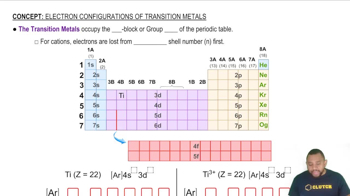Here are the essential concepts you must grasp in order to answer the question correctly.
Electron Configuration
Electron configuration describes the distribution of electrons in an atom's orbitals. For transition metals like copper (Cu), this involves filling the 3d and 4s orbitals. Understanding the order in which these orbitals are filled is crucial for determining the number of electrons in specific subshells.
Recommended video:
Electron Configuration Example
Transition Metals
Transition metals are elements found in the d-block of the periodic table, characterized by their ability to form variable oxidation states and colored compounds. Copper, as a transition metal, has unique electron configurations that influence its chemical properties and the number of d electrons it possesses.
Recommended video:
Periodic Table Trends
The periodic table organizes elements based on their atomic number and electron configuration, revealing trends in properties such as electronegativity, ionization energy, and electron affinity. By understanding these trends, one can predict the behavior of elements like copper and determine the number of electrons in specific orbitals, such as the 3d subshell.
Recommended video:

 Verified step by step guidance
Verified step by step guidance


